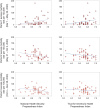State-level public health preparedness indices as predictors of COVID-19 mortality outcomes: results from the United States of America in 2020
- PMID: 38455903
- PMCID: PMC10910973
- DOI: 10.3389/fepid.2023.1229718
State-level public health preparedness indices as predictors of COVID-19 mortality outcomes: results from the United States of America in 2020
Abstract
This study evaluates associations between state-level preparedness indices and reported COVID-19-related mortality outcomes in all 50 states and the District of Columbia in the United States of America during three distinct time periods throughout the first year of the COVID-19 pandemic. State-level preparedness data for the year 2019 were gathered from the National Health Security Preparedness and Trust for America's Health Indices, and COVID-19-related mortality data for March-December 2020 (i.e., excess mortality and reported COVID-19 mortality rates) were collected in May 2022. Linear regression analyses were conducted to examine associations during three distinct time periods. Statistically significant positive associations were observed between both indices and reported COVID-19 mortality rates during the first time period. A statistically significant negative association was observed between one preparedness index and excess mortality during the second time period. No other significant associations existed for the outcomes or time periods considered in this analysis. These results demonstrate that state-level preparedness indices were not well attuned to COVID-19-related mortality outcomes during the first year of the pandemic. This suggests that current measures of state-level preparedness may be underinclusive and require a reconceptualization to improve their utility for public health practice.
Keywords: COVID-19; assessment; health security; mortality; preparedness; public health.
© 2023 Boyce.
Conflict of interest statement
The author declares that the research was conducted in the absence of any commercial or financial relationships that could be construed as a potential conflict of interest.
Figures


Similar articles
-
A COVID-19 Lesson: Better Health Emergency Preparedness Standards Are Needed.Health Secur. 2022 Nov-Dec;20(6):457-466. doi: 10.1089/hs.2022.0037. Epub 2022 Nov 11. Health Secur. 2022. PMID: 36367989
-
Validity of the National Health Security Preparedness Index as a Predictor of Excess COVID-19 Mortality.Prehosp Disaster Med. 2021 Apr;36(2):141-144. doi: 10.1017/S1049023X20001521. Epub 2021 Jan 5. Prehosp Disaster Med. 2021. PMID: 33397547 Free PMC article.
-
Pandemic preparedness and COVID-19: an exploratory analysis of infection and fatality rates, and contextual factors associated with preparedness in 177 countries, from Jan 1, 2020, to Sept 30, 2021.Lancet. 2022 Apr 16;399(10334):1489-1512. doi: 10.1016/S0140-6736(22)00172-6. Epub 2022 Feb 1. Lancet. 2022. PMID: 35120592 Free PMC article.
-
Pharmacy Emergency Preparedness and Response (PEPR): a proposed framework for expanding pharmacy professionals' roles and contributions to emergency preparedness and response during the COVID-19 pandemic and beyond.Res Social Adm Pharm. 2021 Jan;17(1):1967-1977. doi: 10.1016/j.sapharm.2020.04.002. Epub 2020 Apr 10. Res Social Adm Pharm. 2021. PMID: 32389631 Free PMC article. Review.
-
Best practices for after-action review: turning lessons observed into lessons learned for preparedness policy.Rev Sci Tech. 2020 Aug;39(2):579-590. doi: 10.20506/rst.39.2.3108. Rev Sci Tech. 2020. PMID: 33046918 Review.
References
-
- United States Government. United States health security national action plan: Strengthening implementation of the international health regulations based on the 2016 joint external evaluation. Washington, DC: United States Government; (2018).
-
- Trust for America’s Health. Ready or not: protecting the public’s health from diseases, disasters, and bioterrorism—2020 issue report. Washington, DC: Trust for America’s Health; (2020).
-
- National Health Security Preparedness Index. Toolkit: 2020 archives. Available at: https://nhspi.org/tools-resources/ (Accessed May 05, 2022).
-
- Haider N, Yavlinsky A, Chang YM, Hasan MN, Benfield C, Osman AY, et al. The global health security index and joint external evaluation score for health preparedness are not correlated with countries’ COVID-19 detection response time and mortality outcome. Epidemiol Infect. (2020) 148(e210):1–8. 10.1017/S0950268820002046 - DOI - PMC - PubMed
LinkOut - more resources
Full Text Sources

